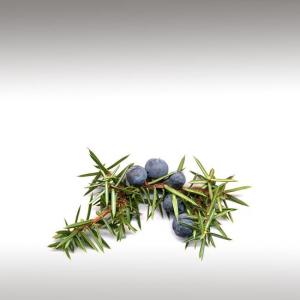
JUNIPER BERRY ESSENTIAL OIL (JUNIPERUS COMMUNIS) - ESSENTIAL OILS

BASE / GENERAL DATA
Information submited: February 3, 2015 Modified: March 13, 2018 By: OperaDreamhouse
Botanical Name: Juniperus communis
Common Method of Extraction: Steam distillation
Part Typically Used: Berries
Color: Clear / Pale
Consistency: Thin
Perfumery Note: Middle
Strength of Initial Aroma: Crisp, woody, sweet, earthy, with almost a hidden fruity note.
Juniperus Communis, the Common Juniper, is a species in the genus Juniperus, in the family Cupressaceae. It has the largest range of any woody plant, throughout the cool temperate Northern Hemisphere from the Arctic south in mountains to around 30°N latitude in North America, Europe, Asia and Japan.
Juniperus Communis is a shrub or small coniferous evergreen tree, very variable and often a low spreading shrub, but occasionally reaching 10 m tall.
It has needle-like leaves in whorls of three, the leaves are green, with a single white stomatal band on the inner surface. The seed cones are berry-like, green ripening in 18 months to purple-black with a blue waxy coating, they are spherical, 4-12 mm diameter, and usually have three (occasionally six) fused scales, each scale with a single seed. The male cones are yellow, 2-3 mm long, and fall soon after shedding their pollen in March - April.
His species grows on dry, open, rocky, wooded hillsides, sand terraces, maritime escarpments, and on exposed slopes and plateaus. It is found on dunes or dune heath in coastal areas, on isolated mountains, and may spread into fields and pastures. Establishment is more likely in open spaces between older shrubs and may be favored by grazing.
Juniperus Communis grows in hilly to alpine regions up to an altitude of more than 3000 m. Common Juniper is intolerant of shade, found in open environments, colonizing plants reach maximum abundance on harsh, stressed environments in which competition is lacking. It grows on poor sites, tolerates full sun and wind and is pH adaptable.
All Juniper species grow berries, but some are considered too bitter to eat.
Juniper oil can be extracted from the berries, as well as the needles and wood. Juniperus Communis oil extracted from the berries is a more superior essential oil than that extracted from the twigs and needles. Do not confuse Juniper Berry essential oil with Cade essential oil, which is distilled from Juniper Wood (Juniperus Oxycedrus).
Common Method of Extraction: Steam distillation
Part Typically Used: Berries
Color: Clear / Pale
Consistency: Thin
Perfumery Note: Middle
Strength of Initial Aroma: Crisp, woody, sweet, earthy, with almost a hidden fruity note.
Juniperus Communis, the Common Juniper, is a species in the genus Juniperus, in the family Cupressaceae. It has the largest range of any woody plant, throughout the cool temperate Northern Hemisphere from the Arctic south in mountains to around 30°N latitude in North America, Europe, Asia and Japan.
Juniperus Communis is a shrub or small coniferous evergreen tree, very variable and often a low spreading shrub, but occasionally reaching 10 m tall.
It has needle-like leaves in whorls of three, the leaves are green, with a single white stomatal band on the inner surface. The seed cones are berry-like, green ripening in 18 months to purple-black with a blue waxy coating, they are spherical, 4-12 mm diameter, and usually have three (occasionally six) fused scales, each scale with a single seed. The male cones are yellow, 2-3 mm long, and fall soon after shedding their pollen in March - April.
His species grows on dry, open, rocky, wooded hillsides, sand terraces, maritime escarpments, and on exposed slopes and plateaus. It is found on dunes or dune heath in coastal areas, on isolated mountains, and may spread into fields and pastures. Establishment is more likely in open spaces between older shrubs and may be favored by grazing.
Juniperus Communis grows in hilly to alpine regions up to an altitude of more than 3000 m. Common Juniper is intolerant of shade, found in open environments, colonizing plants reach maximum abundance on harsh, stressed environments in which competition is lacking. It grows on poor sites, tolerates full sun and wind and is pH adaptable.
All Juniper species grow berries, but some are considered too bitter to eat.
Juniper oil can be extracted from the berries, as well as the needles and wood. Juniperus Communis oil extracted from the berries is a more superior essential oil than that extracted from the twigs and needles. Do not confuse Juniper Berry essential oil with Cade essential oil, which is distilled from Juniper Wood (Juniperus Oxycedrus).

SPIRITUAL PRACTISES DATA

MEDICINE / HEALTH DATA

BEAUTY / COSMETICS DATA

FOOD / COOKING DATA
COMMENTS
No comments.


